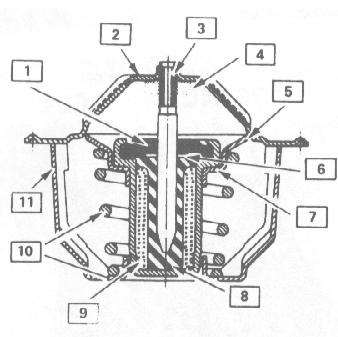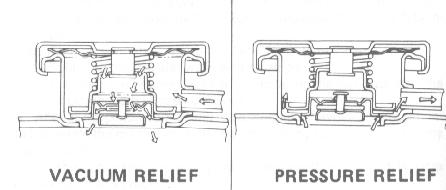|
|
|

| 1. Flange Seal | 5. Valve Seal | 9. Wax Pellet |
| 2. Flange | 6. Teflon Seal | 10. Coil Spring |
| 3. Piston | 7. Valve | 11. Frame |
| 4. Nut | 8. Rubber Diaphragm |
To reduce temperature in the engine, you can dril a 8th" hole in the top of the frame. This should reduce temperature to the halfway mark, or lower. If you want a cooler engine, drill a larger hole, or another 8th" hole. I have done this, and have two different thermostats for mine. One, OEM for winter, and the one with the 8th" hole for summer.
If the thermostat does not open when it should, the engine will overheatm,
and the radiator cap will open. If the thermostat is always open,
or stuck, the engine will not reach normal operating tempurature.
LOW tempurature will cause the vehicle to fail emissions testing as the
car ages, and pollutants increase with age. The Catalytic converter
will not get as hot as it should, thus causing the failure.
PRESSURE & VACUUM RELIEF

Vacuum Relief is when you have a lack of coolant in the system. It will draw coolant from the plastic overflow container, which is also filled with coolant, within specifications.
Pressure relief is when the the coolant expands in the engine with heat, and excess is deposited into the container. If you overfill the radiator, any extra coolant will go into the overflow container. This is also a warningn indication that the engine is overheating due to a bad thermostat, or the cap is no longer within the pressure specifications.
As mentioned elsewhere, if the thermostat is weak, and the pressure is released at lower tempuratures, you can lose most or all of your coolant through the radiator cap, into the overflow bottle. From there, to the ground through an overflow tube, that is in the overflow container.
If the cap has a too high setting for pressure releace, you can blow hoses or a head gasket if the thermostat would fail to open. Too much pressure would build up in the system.
The thermostat usually goes bad before the cap does. The system itself can be pressure tested, with a special tool used at an auto repair shop. They place a tool with a pump on the Radiator, then place the cap on top of their tool. With this, the pressure release can be measured when they pump air into the system to see when the cap releases. Replace the cap if not within specification.